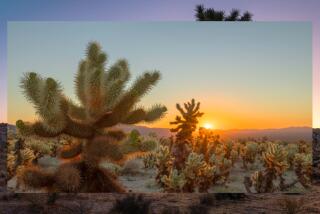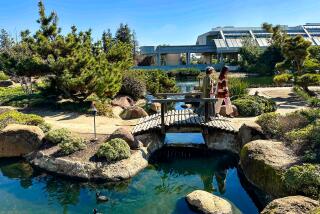Picture-perfect Phuket
I was on a quest to find the world’s most beautiful beach, a place that would tower above its competition. Dazzling white sand, a perfect crescent-shaped bay and crystal clear sea. Instead I found one of the most beautiful spots on Earth -- Phuket, an island off the isthmus of Thailand.
It all started last spring in a dentist’s office as I thumbed through the November 2001 issue of Condé Nast Traveler. I was surprised to read that Phuket beat Bora-Bora (my future dream vacation) in a readers’ poll of the top 10 tropical islands in the world. Phuket was listed at No. 4; the French Polynesian isle was No. 10. Maui came in first.
Although I’ve always liked beaches, they don’t necessarily top my list of summer vacation criteria. Fish do. My husband, Rolf, daughter Talia, 14, and I are scuba-diving junkies, and the Andaman Sea, which surrounds Phuket, is considered a treasure-trove for diving -- warm, clear water, colorful marine life, fascinating wreck sites. So seeing Phuket (pronounced poo-ket) heralded as a great island -- along with the fact that it is a far cheaper destination than Bora-Bora -- made the decision easy.
I was so hyped about planning this exotic late-summer trip that I made a huge mistake: August is in the middle of monsoon season in Southeast Asia. I booked the airline tickets (including a four-day stop in Japan) and reserved a week’s stay at JW Marriott Phuket Resort and Spa. I had thought of everything -- except the weather. I learned about a week later that November through mid-March is the dry season. April and May are the hottest months, but it’s hot and humid year-round. Unfortunately, we were committed. Diving would probably be a given, even if it rained -- we’d be thoroughly wet anyway. But for non-diving days and non-diving family members, including our daughter Marisa, 20, and our 2-year-old son, Kai, we packed toys, games, books and puzzles in the event of an unrelenting monsoon.
After four hot, steamy days in Kyoto, Japan, we flew into Phuket in the early evening to what looked like the end of a gorgeous day. No monsoon here. Just a few pink clouds in a red-streaked sky that promised more sun for the morrow.
The 13-by-30-mile island of Phuket is 540 miles south of Bangkok, about 1 1/2 hours by air. It is connected to the Thai mainland by two bridges and is framed by sandy beaches on its west side and muddy beaches on the east. There is one national park, Khao Phra Thaeo, which has hiking trails and a waterfall, and numerous islets off the coast that provide divers with plenty of reef walls for marine life. Phuket Town is the main city; its architecture is distinguished by several early 20th century Chinese-style buildings that once were home to Chinese immigrants who arrived to work in the region’s tin mines.
The island became a province when the government became a constitutional monarchy with a parliament in 1933. Because of tourism, it is the wealthiest of Thailand’s provinces, though poverty is still visible to tourists in the towns and side streets.
Phuket’s accommodations are mostly in large luxury resorts, all of which are on the western side of the island. There are few midrange accommodations, some cheap hotels and one campground. But luxury here is more affordable than in most Western countries. Most rooms are less than $200 per night. Gourmet room service entrees are $8 each. One-hour massages on the beach by freelance masseuses are $6. So you can live like a wealthy person without having a bank account to match.
The Marriott resort is on Hat Mai Kao, a beach and marine turtle preserve on the northwest section of the island. It’s away from any town or any other hotel, which is good and bad. Good because beaches are relatively empty -- no vendors bugging you. But getting to town for shopping, activities or tourist sites is a 40-minute trip, so if you feel trapped or want to try other restaurants, it’s a long taxi ride.
Besides regular hotel rooms, half the resort is part of Marriott’s Vacation Club, of which we are members, so the week was part of our annual time-share trade. But membership isn’t necessary to rent the 54 two-bedroom villas. These have kitchens, a laundry closet and two bathrooms. They are available off-season for $260 per night and gave us lots of room to spread out.
At check-in we were greeted with jasmine leis, an icy lime drink and staff members who gave the traditional greeting -- holding their palms together and bowing. The resort’s open-air lobby was full of exotic flowers, costumed musicians playing traditional Thai instruments, a pond with a Buddhist shrine and a reflecting pool lighted with torches. It was so lush we felt giddy.
The next day I was determined to find a world-class beach. The Marriott’s beach was narrow, its sand brown and coarse; the waves were too rough to swim in during monsoon season. We hired a taxi and asked the driver (many speak some English) to stop at the island’s most beautiful beach areas, including Laguna, Patong, Karon and Kata. At every stop we got out, walked in the sand, observed the water’s clarity, eyeballed the distinguishing landmarks. All were pretty, somewhat crowded, but none took my breath away.
“I guess I just don’t know what I’m looking for,” I told Talia.
“You are looking for the postcard beach,” she said. “The one with no tourists, the leaning palm tree, an empty hammock.” Despite the monsoon season, the island was crowded, our hotel booked. We probably wouldn’t see empty beaches.
But Talia was right about the postcard ideal. Maybe beaches like that don’t exist. One year on the Honduran island of Roatán in the Caribbean Sea, we thought we had found such a beach. But as we sat there for pictures, the sand flies made pincushions of our legs. Perhaps nature is only pretty in photos.
I was satisfied we’d seen the island’s best, so we continued with the week’s planned activities, happy that each day was sunny and clear, though quite hot (90s) and humid (80% to 90%). We rode elephants through a jungle to see beautiful birds such as the blue and tan Indian roller; shopped for cheap sarongs ($1.50), batik shirts and carved wood elephants in Phuket Town; and visited two Buddhist temples. We went scuba diving at thick coral reefs that had more colorful fish than we’d encountered elsewhere, and we spent a day getting tropical fruit drinks delivered at the hotel pool, where a children’s water slide and toy area kept Kai happy for hours.
Finding the dream beach
Two days before our week was over I walked up to the ever-smiling concierge -- who would always bow and say, “How may I serve you?” (boy, do I miss him) -- and asked if we’d properly covered the island’s activities. “Have you taken a boat trip over to the Phi Phi Islands?” he asked, handing me a brochure about two islands 28 miles southeast of Phuket. There it was, a photo of the perfect beach I’d been searching for. In fact, Leonardo DiCaprio spent time on one of the islands filming “The Beach” in 2000. The movie was dreadful, but I remember thinking that such a beautiful beach couldn’t possibly be real.
We booked a day trip with Phuket Island Hopper. The $100-per-person cost included speedboat transportation from the hotel and multiple stops for snorkeling, swimming, sunbathing and lunch. This being monsoon season, the waves were choppy, but that didn’t deter the captain from running full throttle. The 45-minute trip turned into agony for several passengers, who began to turn green and ran for the back of the boat.
The interminable ride ended when the boat turned into Phi Leh Cove, a lagoon encircled by five-story limestone monoliths rising straight up out of the sea. The blue-green water sparkled, and a pristine white-sand beach awaited, though it was already heavily dotted with visitors. The sight was unreal in its beauty and color. The captain shut off the engines and we jumped into the 89-degree water to snorkel. The coral gardens and colorful fish -- blue-lined groupers, orange coral rock cod and green moray eels -- were stunning.
When the captain sounded the bell for passengers to reboard, it was hard to leave, but this was only the first of several postcard-perfect lagoons on the schedule. The second stop was a deep swimming hole also surrounded by limestone rocks, the third a beach called Monkey Bay, where monkeys played in the trees and took pieces of bread from tourists. We peeked into Viking Cave, a karst cave where tiny fork-tailed swifts build their nests on the ceiling. They are eventually retrieved for birds’ nest soup.
Lunch was at a so-so restaurant on Phi Phi Don, where accommodations are rustic, backpacker quality. We swam and snorkeled some more before the noisy, bumpy ride home.
Next time? It’s not hard to imagine going back one day. But next time I’d go in the dry season, when the water is calmer. It rained only on the ride back to the airport, so we lucked out. And I’d plan to spend more time on the postcard beaches, crowded or not.
More to Read
Sign up for The Wild
We’ll help you find the best places to hike, bike and run, as well as the perfect silent spots for meditation and yoga.
You may occasionally receive promotional content from the Los Angeles Times.






